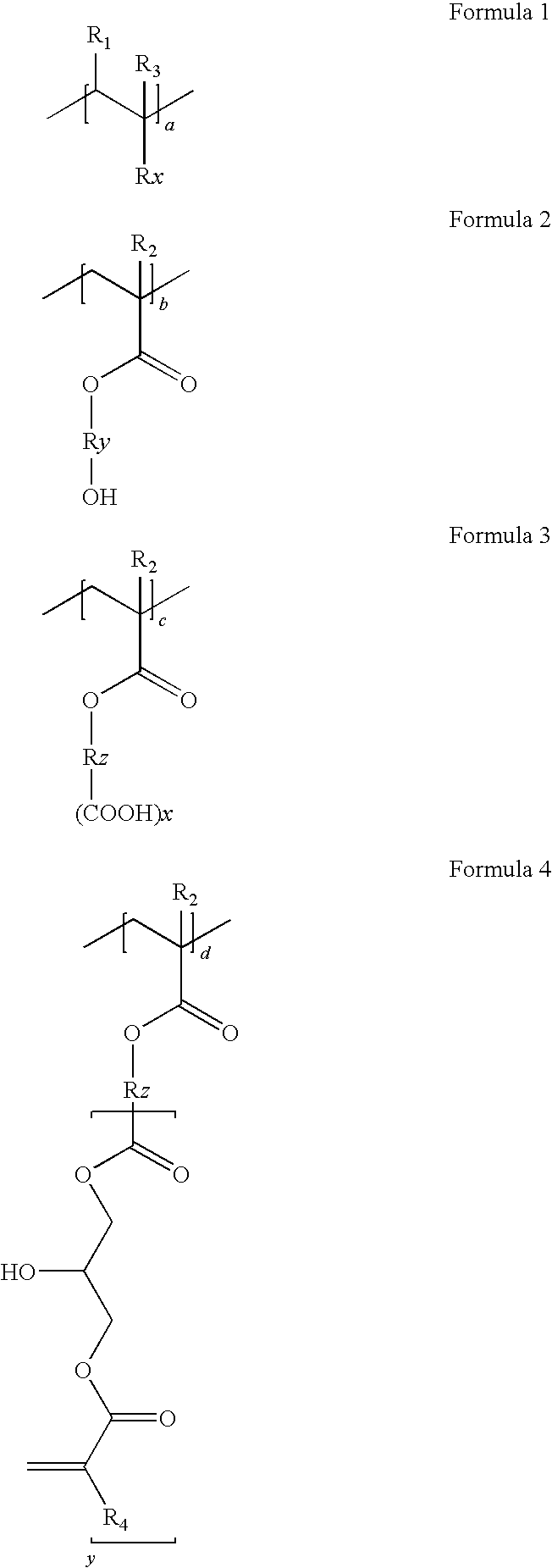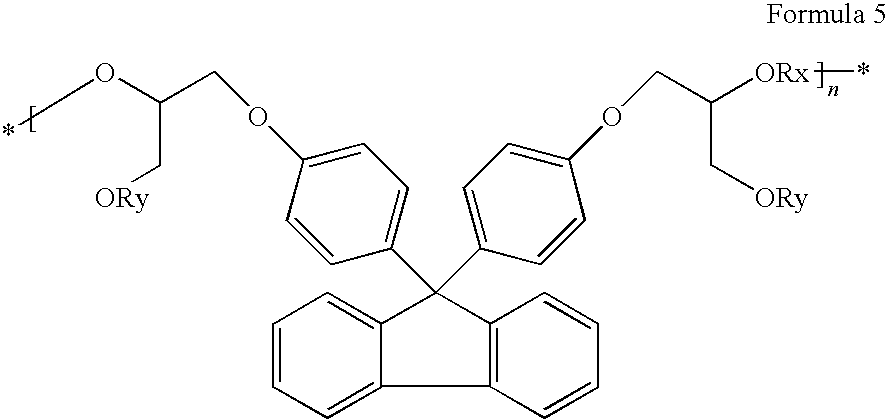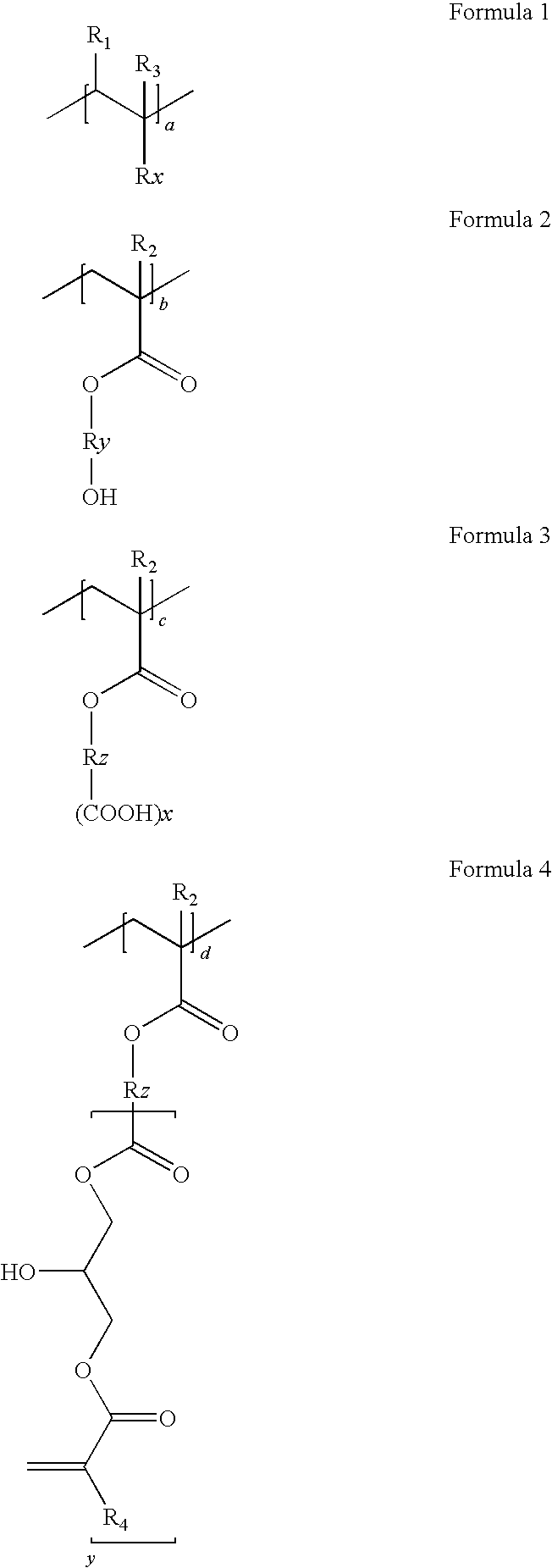Colored dispersion, photoresist composition and black matrix
a composition and black matrix technology, applied in the field of colored dispersion, photoresist composition and black matrix, can solve the problems of difficult to handle compositions, high reflectivity of chromium and environmental pollution, and high cost, and achieve the effects of improving adhesion to substrates, high light-shielding properties, and stable dispersion with other components
- Summary
- Abstract
- Description
- Claims
- Application Information
AI Technical Summary
Benefits of technology
Problems solved by technology
Method used
Image
Examples
example
Example 1
(The Preparation of Colored Dispersion 1)
[0073]Colored dispersion 1 (a carbon content of 20%) is obtained by dispersing for five hours 1000 g of carbon black (special black 550), 500 g of a dispersion (disperbyk 168, 30%), 500 g of a binder (benzylmethacrylate / styrene / hydroxyethylmethacrylate / succininc anhydride adding hydroxyethylmethacrylate / glycidylmethacrylate adding succinic anhydride adding hydroxyethylmethacrylate (molar ratio: 20 / 20 / 10 / 30 / 20, acid value: 78, Mw=18,000 and solid: 30%), 3000 g of propyleneglycolmonomethyletheracrylate and a zirconia beads, using a dispersing equipment.
(The Preparation of Photoresist Composition 1)
[0074]900 g of the obtained colored dispersion 1, 50 g of a alkali-soluable resin binder (benzyl(meth)acrylate / styrene / N-phenylmaleimide / (meth)acrylic acid / glycidylmethacrylate adding methacrylic acid (molar ratio: 42 / 8 / 6 / 24 / 20, Mw=15,000, acid value: 84 KOH mg / g), 50 g of dipentaerythritolhexaacrylate as a functional monomer, 20 g of 1-(O-ac...
example 2
(The Preparation of Colored Dispersion 2)
[0076]Colored dispersion 2 (a carbon content of 20%) is obtained by dispersing for five hours 1000 g of carbon black (special black 550), 500 g of a dispersion (disperbyk 168, 30%), 500 g of a binder (benzylmethacrylate / styrene / hydroxyethylmethacrylate / tetrahydrophthalic anhydride adding hydroxyethylmethacrylate / glycidylmethacrylate adding tetrahydrophthalic anhydride adding hydroxyethylmethacrylate (molar ratio: 20 / 20 / 5 / 35 / 20, acid value: 79, Mw=20,000, solid: 30%), 3000 g of propyleneglycolmonomethyletheracrylate and a zirconia beads, using a dispersing equipment.
(The Preparation of Photoresist Composition 2)
[0077]Photoresist composition 2 is prepared by the same method as that in example 1, except for using colored dispersion 2.
example 3
(The Preparation of Colored Dispersion 3)
[0078]Colored dispersion 3 (a carbon content of 20%) is obtained by dispersing for five hours 1000 g of carbon black (special black 550), 500 g of a dispersion (disperbyk 168, 30%), 500 g of a binder (dicyclopentanylmethacrylate / benzylmethacrylate / hydroxyethylmethacrylate / 1,2,4-benzentricarboxylic anhydride adding hydroxyethylmethacrylate / glycidylmethacrylate adding 1,2,4-benzentricarboxylic anhydride adding hydroxyethylmethacrylate (molar ratio: 30 / 20 / 10 / 20 / 20, acid value: 82, Mw=20,000, solid: 30%), 3000 g of propyleneglycolmonomethyletheracrylate and a zirconia beads, using a dispersing equipment.
(The Preparation of Photoresist Composition 3)
[0079]Photoresist composition 3 is prepared by the same method as that in example 1, except for using colored dispersion 3.
PUM
| Property | Measurement | Unit |
|---|---|---|
| boiling point | aaaaa | aaaaa |
| temperature | aaaaa | aaaaa |
| temperature | aaaaa | aaaaa |
Abstract
Description
Claims
Application Information
 Login to view more
Login to view more - R&D Engineer
- R&D Manager
- IP Professional
- Industry Leading Data Capabilities
- Powerful AI technology
- Patent DNA Extraction
Browse by: Latest US Patents, China's latest patents, Technical Efficacy Thesaurus, Application Domain, Technology Topic.
© 2024 PatSnap. All rights reserved.Legal|Privacy policy|Modern Slavery Act Transparency Statement|Sitemap



